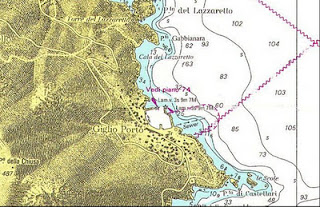Wednesday
Jan182012
Interview with Local Skipper on the sinking of the Costa Concordia
 Wednesday, January 18, 2012 at 3:10PM
Wednesday, January 18, 2012 at 3:10PM
 |
| Nautical charts of the area (depth in meters) |
I recently was fortunate enough to interview Luigi Cota, Yepa Sailing Team Skipper - Managing director of Cantieri Navali del Mediterraneo (CNM) spa, who has sailed the isles of the Tuscan Archipelago countless times, which is the area where the Costa Concordia capsized on Friday night on the rocks by the island, Giglio. Cota lives in Rome, and describes the Isola del Giglio (Giglio island) as “really beautiful and has many nice coves where we go for a swim or to spend the night at anchor.”
Cota typically sails 30 to 60 feet sailboats, and when he thinks of dangers at sea he thinks of terrible weather and “angry seas” rather than human error.
 |
| Nautical charts of the area (depth in meters) |
Cota explains, “What is most surprising about all this situation is that Giglio is a fairly safe island since it doesn't have many hidden rocks or dangerous shallows, except the one that the Concordia hit. The most likely reconstructions of the events show that the ship, before landing on Punta Gabbianara (where it's now), hit one of the rocks off Punta Castellari, those rocks are called Le Scole. Le Scole are very famous since everybody that comes from 2 of the most famous coves of the island (Caldane and Cannelle) going to the small harbor have to keep clear.”
Cota continues to clarify, “I'd like to enhance the paradox that, from my experience as a sailor, it is hard to anchor around the island because it's actually very deep near the shore, whereas the cruise ship found danger because he hit the only (well known) rock that is there!”
Based on what Cota explains, this rock in question seems to very well known and it leaves the question, how can a modern cruise ship with all of its modern navigation equipment at its disposal, make such a terrible error? I feel like a lot more will surface as the investigation continues.

Reader Comments (2)
Great blog post. It's very insightful and presents a nice perspective from Luigi. I'll continue to watch this story unfold.
Nice to hear from Luigi's concern and knowledge that there are many responsible ship captains out there. That is to say, one hopes the beautiful tradition of boating, whether on small sail boats or luxury vessels continues to inspire navigators and tourists. More importantly, one hopes this unfortunate accident enhances the education of safety procedures among crew members and the liability of ship captains in order for that to happen.